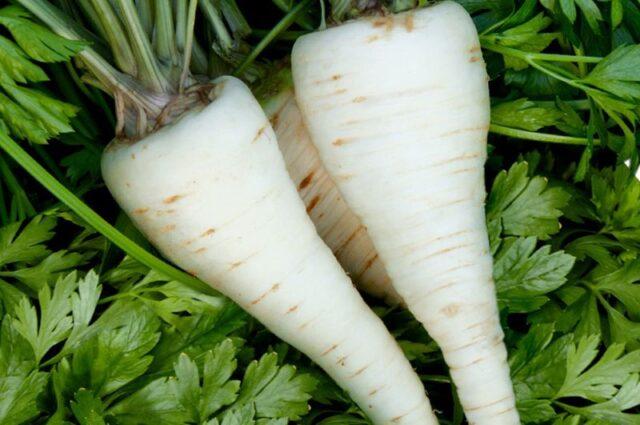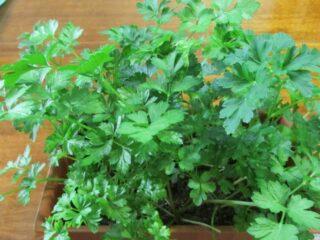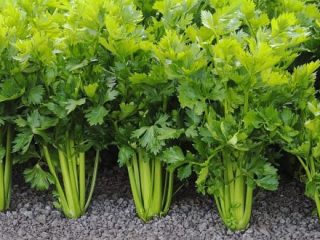Content
- 1 Description and characteristics of root parsley
- 2 What is the difference between root parsley and leaf parsley?
- 3 The best varieties of root parsley
- 4 When to Plant Root Parsley
- 5 What kind of soil does root parsley like?
- 6 How to plant root parsley
- 7 How long does root parsley grow?
- 8 Root parsley care
- 9 When to dig up root parsley
- 10 How to store root parsley at home
- 11 Conclusion
Root parsley is a healthy and tasty variety of herb. It is grown in almost the same way as leafy, in accordance with simple rules.
Description and characteristics of root parsley
Root parsley (Petroselinum crispum var. tuberosum) is one of the varieties of common curly parsley of the Apiaceae family. It has a straight ribbed stem and bright green dissected leaves, smooth or corrugated, triangular in shape. The root of the plant is spindle-shaped, thickened.
Greens have a two-year life cycle.In the first season in spring, a leaf rosette of 30-40 individual plates is formed, and by the end of summer a root crop with dense pulp and a yellowish or white skin grows. In the second year in June or July, the crop produces a long peduncle with greenish-yellow umbrella inflorescences. The fruits of the plant are oblong-ovoid in shape, the seeds are dark and elongated, with characteristic stripes.

The height of root parsley can be about 1 m
What is the difference between root parsley and leaf parsley?
The two varieties of greens are very similar, and it can be difficult to tell them apart. You need to look mainly at the above-ground plates. The leaf variety has many of them, about 100 per plant, while the root variety has only 40 or less.
In addition, the difference can be noticed when examining root vegetables. In root greens, the underground part is large and massive, while in leaf greens it is long, thin, branched into many branches.
The best varieties of root parsley
Before planting a plant on the site, it is worth studying the most popular varieties. Several varieties are valued for their high nutritional qualities.
Sugar
Early root parsley allows you to harvest root crops approximately 98 days after germination. They reach a length of 30 cm, the weight can be about 60 g. The variety contains a large amount of ascorbic acid and carotene, and has high yields. The leaves also have a good taste - they are soft and juicy.

Sugar parsley was included in the State Register back in 1950
Jadran
Parsley of this variety ripens slowly - it takes 193 days to grow it from the emergence of shoots. But the variety is valued for its good keeping quality. Yadran is optimal for winter storage in the cellar. Parsley has a smooth white root up to 22 cm long without branching and produces a spreading rosette of leaves.

The Yadran variety rarely suffers from fungal diseases
Harvest
In accordance with the name, root parsley gives very good yields - up to 3.6 kg of root vegetables per 1 m2. The advantages include the length of the rods up to 30 cm, rich taste and high content of vitamins. It is used both fresh and canned.

Harvest parsley has few leaves, but they are tasty, and they can be cut several times during the season.
The final
A mid-season variety of root parsley produces very large root crops weighing up to 190 g. Shows good yield - more than 2.5 kg per 1 m2. The root length is about 25 cm, the rod has a cone-shaped shape without branching. The pulp of the variety is white, the skin is light gray.

The Final variety is suitable for drying, freezing and canning
When to Plant Root Parsley
Root parsley should be planted in the spring after positive temperatures have established. The crop germinates already at 3-4 °C; seeds can be planted in the soil at the end of April. It is advisable to complete sowing by mid-May.
What kind of soil does root parsley like?
Root parsley should be grown in the garden on loamy and sandy loam soils. The culture develops well in the area where dill, coriander or carrots were planted before it. It is important that there is no fresh manure in the soil, otherwise the root crops may grow branchy.
How to plant root parsley
Green crops are traditionally grown from seeds. They can be sown in several ways - directly into the soil, into a home seedling container, or into a closed greenhouse.
How to grow root parsley from seeds in open ground
Growing root parsley in open ground is most often practiced - the crop takes root well. The site for the plant is prepared in the fall. The soil is dug up to a shallow depth of up to 30 cm, all weeds are removed and 5 kg of humus is added per meter of space. With the onset of spring, the soil will need to be loosened again and complex mineral fertilizers added - 25 g of nitrophoska and 50 g of ammonium nitrate per meter.
Root parsley should be planted in open ground according to the following scheme:
- Two weeks before sowing, the seeds are soaked in warm water for 48 hours to speed up the awakening of the material.
- After the expiration date, the grains are washed and placed on a piece of gauze for 5-6 days until the sprouts appear.
- The seeds are placed in the refrigerator for another ten days, after which they are dried.
- In a garden plot, grooves 2 cm deep are dug in the ground with intervals of 20 cm between rows.
- Water the soil generously and place the seeds in the depressions, and then sprinkle 1 cm of soil on top.
- The bed is covered with film for 2-3 days to retain moisture for a long time.
If desired, you can water the seeds after they have been buried, but in this case there is a risk of blurring the grooves.

Due to the high content of essential oils, the seeds are difficult to germinate, so they must be soaked
Growing root parsley through seedlings
The seedling method for greens is rarely used. It does not give the gardener any special advantages, but when transferring plants into the ground there is a risk of damaging their underground system.
You need to sow root parsley in boxes like this:
- Before planting, seeds are soaked in the standard way to swell, wait until sprouts appear and put in the refrigerator for ten days.
- Nutrient soil consisting of disinfected garden soil and humus is poured into shallow but wide containers.
- Furrows 1-2 cm deep are made in the soil and seeds are planted in them.
- Sprinkle the planting material on top with soil and spray it generously with a spray bottle.
- Cover the containers with film for several days, remembering to regularly remove it for ventilation.
You need to grow seedlings in a well-lit place at a temperature of about 25 ° C, carefully monitoring soil moisture. When the root parsley produces its first true leaves, the heat will need to be reduced to just 18 °C
The seedlings need to be transferred to the ground in mid-May, after the heat has finally set in. This is done very carefully; it is advisable, in principle, not to expose the root system of the sprouts, but to plant them in the garden using the transshipment method.

When grown in small pots, it will be easier to transfer parsley into the ground without disturbing the earthen coma.
When grown in small pots, it will be easier to transfer parsley into the ground without disturbing the earthen coma.
Planting root parsley in a greenhouse
The crop can be grown in a greenhouse. The algorithm is almost no different from planting in open ground:
- Shallow furrows are made in previously prepared soil, placing them in rows at intervals of 20-30 cm.
- The seeds are soaked in water to swell and stratified in the refrigerator after sprouting.
- The material is sown in the depressions made and sprinkled with a layer of soil, and then the beds are irrigated from above, trying not to erode the soil.
- For 2-3 days, planting is covered with film, and then the cover is removed.
The main advantage of a greenhouse is that you can sow crops at the end of January, without waiting for spring to arrive. Root parsley is grown in the standard way, but when planting early, additional illumination with fluorescent lamps is used. The daytime sun at the end of winter is still too little for the successful development of the crop.

When grown in a greenhouse, root parsley needs to be maintained at a temperature of about 12 °C.
How long does root parsley grow?
The ripening time of root parsley depends on its variety. Early varieties produce a harvest 2.5 months after germination, medium and late varieties - after 100-200 days. In general, the life cycle of any parsley, root or leaf, takes two years.
Root parsley care
The culture has sufficient endurance and unpretentiousness. But for good germination it needs to be provided with favorable conditions. The agricultural technology of root parsley when grown in the ground and in a greenhouse is approximately the same.
Weeding and loosening
Green seeds take quite a long time to germinate and require mandatory loosening of the soil for good oxygen saturation. For the first time, the procedure is carried out approximately a week after sowing. It is advisable to mark the grooves with root parsley in advance with marks. It will be more convenient to loosen the soil along the exposed beacons to a depth of about 6 cm.
Planting and caring for root parsley requires the mandatory removal of weeds as they appear.Foreign plants should not interfere with the development of the crop and take away valuable substances from it.
Thinning
The first thinning for root parsley is carried out immediately after emergence. Between strong seedlings, 2.5 cm of free space is left, the remaining sprouts are removed.
The procedure is carried out again after two weeks. This time the distance between the seedlings should be about 7 cm.
Watering
The culture develops well in moist, but not swampy soil. Water is applied at the root, in the morning and evening; you can also use the drip irrigation method. The frequency of the procedure is adjusted according to the amount of precipitation. During heavy rainfall, there is no need to water the greens; during drought, daily moisture must be provided.
The condition of the soil is monitored especially closely during the period of ripening of root crops of a particular variety. The soil should not dry out at this time.

Root parsley needs to be watered 20-25 liters per meter of plantings
Top dressing
To obtain a tasty and juicy harvest, it is recommended to feed root parsley with mineral fertilizers. The first time they are applied after the appearance of three true leaves - 15 g of ammonium nitrate is added per meter of soil.
The second feeding is carried out three weeks later. 10 g of superphosphate and 5 g of ammonium nitrate and potassium salt are added to a similar area.
When to dig up root parsley
The exact timing of harvest depends on the plant variety. But traditionally, it is recommended to dig up root parsley in the fall at the end of September or October on a dry and sunny day. The green leaves are first cut down to a small stump, and the underground part is removed from the soil and left to dry in the garden bed.After this, the fruits are sorted and damaged and rotten specimens are thrown away.
How to store root parsley at home
Storing root parsley after harvesting is carried out in several ways:
- Dry sand. Immediately after harvesting, the root crops are sorted, laid out in wooden boxes and sprinkled with sand so that they do not touch each other. The containers are placed in the cellar at a temperature of 0-2 °C and the preparations are periodically checked throughout the winter, promptly removing rotten or dried fruits.
- Freezing. You can store root parsley in the freezer. First, the fruits are washed and blanched in boiling water for about five minutes, and then dried and cut into circles or strips. The raw materials are laid out in plastic bags and the air is removed from them, and then the workpiece is put into the freezer.
- Drying. The washed and peeled roots are cut and placed in the oven at a temperature of about 60 °C for 3-4 hours. When the slices become crispy and brittle, they will need to be packaged in clean jars or fabric bags and stored in a dry, dark place.
When storing root parsley at home in the cellar and freezer, the root vegetables retain their nutritional properties for up to six months. In dried form, they can be consumed for up to two years.

Dried parsley is good for use as a seasoning in soups and side dishes.
Conclusion
Root parsley is a plant with low requirements for growing conditions. To get a good harvest, it is enough to follow the basic planting rules and pay attention to watering and fertilizing the crop.








